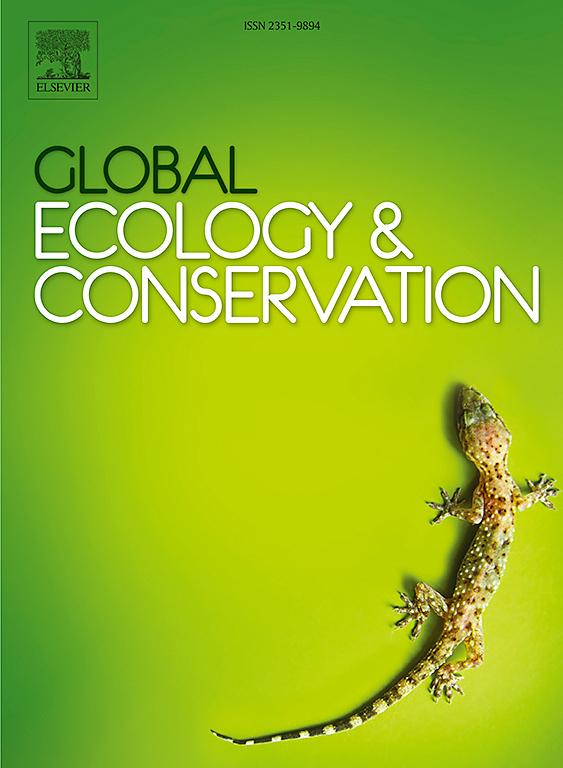Assessing typhoon impacts on mangroves and post-typhoon recovery patterns to inform projects using mangroves as nature-based solutions
IF 3.5
2区 环境科学与生态学
Q1 BIODIVERSITY CONSERVATION
引用次数: 0
Abstract
On July 18, 2014, Super Typhoon Rammasun caused significant damage to a mangrove forest at Dongzhaigang Bay, Hainan Island. To evaluate the structural damage and recovery patterns of mangrove forests, vegetation in permanent plots was surveyed at 1, 12, and 24 months after the event. Six mangrove species were assessed, including five native species (Kandelia obovata, Bruguiera sexangula, Rhizophora stylosa, Avicennia marina, and Ceriops tagal) and one exotic species (Sonneratia apetala). Results revealed that mangroves exhibited species-specific resistance and resilience to the super typhoon. S. apetala and B. sexangula were the most severely affected, followed by K. obovata, R. stylosa, and A. marina. C. tagal was the least impacted, indicating its high resistance. The extent of damage at community level had a significant positive correlation with basal diameter and tree height, and a negative correlation with the tree density. S. apetala, A. marina, and R. stylosa displayed rapid recovery after the event, indicating their high resilience. However, B. sexangula and K. obovata had notably high mortality one year after the disturbance. Species traits (e.g. refoliation or resprouting) interact with environmental factors such as changes in hydrology in producing post-hurricane recovery patterns. Damage and recovery from storms varies among species indicating that diverse assemblages are important for sustainability of projects using mangroves as nature-based solutions under a changing climate with increasing storm strength and frequency.
评估台风对红树林的影响和台风后的恢复模式,为利用红树林作为基于自然的解决方案的项目提供信息
2014年7月18日,超强台风“威马逊”对海南岛东寨港湾红树林造成严重破坏。为了评估红树林的结构破坏和恢复模式,在灾害发生后1个月、12个月和24个月对永久样地的植被进行了调查。共对6种红树进行了评价,包括5种本地种(红树Kandelia obovata, Bruguiera sexangula, Rhizophora stylosa, Avicennia marina和Ceriops tagal)和1种外来种(无瓣海桑)。结果表明,红树林对超强台风表现出特有的抗性和抗灾能力。其中,无瓣莲和黄花莲受影响最严重,其次为大叶莲、花柱花和黄花莲。柽柳受影响最小,具有较高的抗性。群落损害程度与基径、树高呈显著正相关,与树密度呈显著负相关。无瓣草、马尾草和柱头草在事件发生后恢复迅速,显示出较高的恢复力。但干扰后1年,黄斑小蠊和小卵小蠊的死亡率明显较高。物种特征(如重叶或再生)与水文变化等环境因素相互作用,从而产生飓风后的恢复模式。风暴造成的破坏和恢复因物种而异,这表明在风暴强度和频率不断增加的气候变化下,多样化的组合对于将红树林作为基于自然的解决方案的项目的可持续性至关重要。
本文章由计算机程序翻译,如有差异,请以英文原文为准。
求助全文
约1分钟内获得全文
求助全文
来源期刊

Global Ecology and Conservation
Agricultural and Biological Sciences-Ecology, Evolution, Behavior and Systematics
CiteScore
8.10
自引率
5.00%
发文量
346
审稿时长
83 days
期刊介绍:
Global Ecology and Conservation is a peer-reviewed, open-access journal covering all sub-disciplines of ecological and conservation science: from theory to practice, from molecules to ecosystems, from regional to global. The fields covered include: organismal, population, community, and ecosystem ecology; physiological, evolutionary, and behavioral ecology; and conservation science.
 求助内容:
求助内容: 应助结果提醒方式:
应助结果提醒方式:


